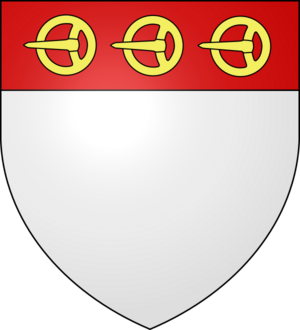John de Strivelyn facts for kids
John de Strivelyn (pronounced STIR-lin), also known as John Stirling, was a brave knight from Scotland who lived a long time ago, from about 1327 to 1378. Even though he was Scottish, he worked for the King of England during a time when England and Scotland often fought.
Contents
Sir John's Military Adventures
Early Battles and Capture
John Stirling first appears in history after the Battle of Halidon Hill in 1333. In March 1335, he became a leader of a combined English and Scottish army. They were trying to capture Loch Leven Castle. One day in June, Stirling was away celebrating a special day for St Margaret. While he was gone, the Scottish defenders of the castle made a surprise attack. But even with this setback, the castle gave up by the end of that summer.
Later that year, in September 1335, Stirling was attacked by surprise near Linlithgow. He was captured and put in prison at Dumbarton Castle. Luckily, he was set free within a year. He then became a special kind of knight called a Knight Banneret for the King of England. This happened at Perth on a day called Saint John's Eve.
Serving the King
On October 10, 1335, John Stirling signed an agreement with King Edward III. He was given control of Edinburgh Castle and the area around Lothian. As the person in charge of Edinburgh Castle, he often asked the king for money to pay his soldiers. In May 1336, he led a daring attack across the Forth River. He drove away Scottish forces who were trying to capture Cupar Castle. Stirling's time at Edinburgh ended in March 1338 when he was captured during another battle.
By the autumn of 1338, Stirling was back with the king's army. This time, they were fighting in a region called the Low Countries (modern-day Belgium and Netherlands). He stayed with the king until late 1339. Then he returned to the British Isles for a winter trip to Scotland. The next winter, in 1341-1342, Stirling joined King Edward's army in Scotland. This was after Edinburgh Castle had been taken by the Scots.
Fighting in Other Lands
In October 1342, John Stirling moved to Brittany (a region in France). He fought in the Breton War of Succession until January 1343. On July 29, 1343, he was chosen to be the sheriff of Northumberland. But he couldn't take the job because he had a bad injury. He was replaced sometime after February 1344. From January 1345 to February 1346, he was in charge of Berwick Castle.
In July 1346, Stirling joined King Edward again for a big trip to Europe. This trip led to the famous Battle of Crécy and the siege of Calais. In March 1347, he went back to the border areas with Scotland, called the Scottish Marches. He served there until October.
Sir John's Fighting Group
As a Knight Banneret, John Stirling led his own group of soldiers, called a 'banner' or 'retinue', during several military campaigns. Here's a look at how many men he led:
| Campaign | Dates | Soldiers in his group |
|---|---|---|
| Low Countries | 1338/1339 | 4 sergeants, 12 archers |
| Scotland | 1340 | 1 knight, 8 men-at-arms, 10 hobelars (light cavalry) |
| Scotland | 1341/1342 | 2 knights, 21 men-at-arms |
| Brittany | 1342/1343 | 2 knights, 18 sergeants, 26 archers |
| France | 1346/1347 | 1 knight, 22 men-at-arms, 26 archers |
| Scotland | 1347 | 3 knights, 17 men-at-arms, 20 archers |
Sir John's Family
Around 1327 or 1328, John de Strivelyn married a woman named Barnaba. She was the daughter of Adam Swinburne from Northumbria. His daughter, Christiana, took over his lands after him. She married a man named John de Middleton.
John Stirling's second wife was Jacoba. She was one of the heirs of Richard de Emeldon.
Lands Sir John Owned
John Stirling held land called the manor of East Swinburne. This land was part of a disagreement at the time. His daughter, Christiana, inherited it from him.
On October 8, 1335, King Edward gave Stirling several manors (large estates with houses and land) in Northumberland. These lands had belonged to John de Middleton but were taken by the king. One of these was Belsay.
On July 12, 1336, the king gave Stirling more manors, this time in Scotland. The king said Stirling would get 200 marks (a type of money) if the Scots took these lands back. Stirling claimed this payment from September 27, 1342. He received money from taxes collected in Newcastle upon Tyne and Hartlepool.
On April 19, 1340, Stirling received two more manors. These were in Berwick and Roxburghshire. They had belonged to Margaret de Abernethy, who was the Countess of Angus.
On May 29, 1343, Stirling was given money from the lands of Aymer de Valence in Yorkshire. He received this money until David de Strathbogie, a young relative of Valence, became an adult. On December 20, the king confirmed that Stirling had bought another manor in Yorkshire called Faxfleet. This helped to pay back some of the 200 mark payment he was owed.
On November 22, 1347, Stirling was given a few more rented lands near Berwick. These lands had previously been held by the Morays of Petty family.
On August 5, 1352, Stirling bought the estate of Newton-by-the-Sea completely from a man named Thomas de St. Maur.
In 1361, Stirling received several properties in Newcastle. These were part of the dowry (money or property brought by a bride to her marriage) from his second wife, Jacoba. She was an heir of Richard de Emeldon, who used to be the mayor of Newcastle and was killed at Halidon Hill.


